2-day shipping is the new normal. Thanks to the likes of Amazon Prime and eBay, customer expectations are at an all-time high, especially when it comes to ordering fulfilment. We’re living in the age of instant gratification, and eCommerce is no exception.
The bottom line is that order fulfilment impacts your bottom line. Brands that fail to compete get left behind. Fulfilling delivery demands at speed isn’t easy, but it lies at the core of modern customer expectations.
Some online retailers opt to outsource their order processing, warehousing, and delivery fulfilment responsibilities. They can then focus their efforts on customer acquisition and retention whilst still ensuring delivery expectations are met.
It doesn’t matter if your product is the best thing since sliced bread. If it fails to arrive promptly, it won’t get the recognition it deserves. 38% of shoppers stop engaging a retailer after a poor delivery experience, whilst 25% will cancel an order due to slow delivery.
eCommerce fulfilment excellence is essential for business success. This article is a go-to guide for all things delivery fulfilment. We’ll start with the basics, before dissecting the ins and outs of fulfilment processes, services, and strategies.
It’s time for your eCommerce store to compete with the big players.
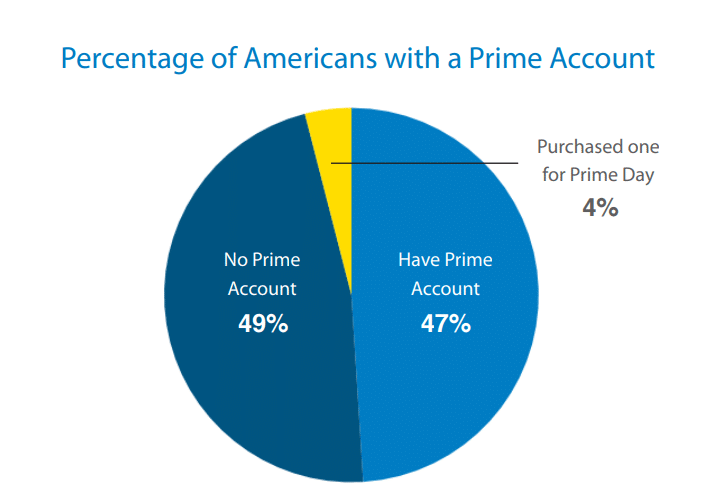
Image by efulfillmentservice.com
What is ECommerce Fulfillment?
ECommerce fulfilment is part of the supply chain process. It begins as soon as a customer completes their purchase. It’s the entire process behind getting an order delivered to that customer. It usually looks something like this:
Receiving and storing inventory →Processing an order → Picking the products →Packing the products → Shipping/ transporting items to the customer
Ensure that this process runs like a well-oiled machine. It’s integral to meeting customer delivery expectations. Streamlining operations takes work. That’s why delivery fulfilment can be completed in-house or outsourced to a third-party logistics provider (3PL).
Excellent eCommerce fulfilment benefits both B2B eCommerce businesses that ship to retailers in large quantities and B2C retailers shipping smaller quantities direct to the customer. But despite its widespread importance, some common misconceptions need debunking.
1. That a fulfilment centre should be close to company headquarters.
Fulfilment centres should be as close to the customer as possible. Analyze order histories to determine shipping zones, shipping costs, and times. Optimize accordingly. Another common misconception is that opting for a rural order fulfilment centre will save money. In reality, what you save in rent, you often spend on shipping and other related fulfilment costs.
2. That it is cheaper to organize order shipping in-house.
True when order quantities are low, but when orders mount up, it’s easy to spend too much time on eCommerce fulfilment. Businesses end up having to fork out on additional workers to keep up with demand. This takes time and money away from growing your business and retaining valuable customers.
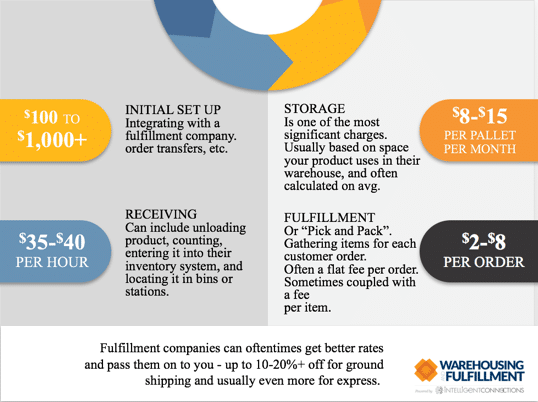
Image by fullfillmentcompanies.net
Ecommerce Fulfillment Process
The fulfilment process includes receiving, storing, processing, shipping, and returning goods. In other words, great delivery fulfilment is not just about delivery. Brands must strive for excellence from pre-purchase (clear delivery information) to beyond the basket (customer service and returns).
Let’s break down each of these steps.
1. Receiving.
This step is about inventory. To fulfil orders, your brand needs a sufficient inventory of products. In-house delivery fulfilment requires inventory that is on the premises—I.e., literally sitting on shelves or pallets in the warehouse. Outsourced fulfilment inventory should be sent directly to your 3PL provider or fulfilment partner.
2. Storage.
This step is about warehousing. Storing inventory in an organized way is critical for effective delivery fulfilment. Each product needs a dedicated storage location. Maintaining good storage practices keeps products secure, visible, and easily retrievable.
3. Processing.
This step is about picking and retrieving. Once an order is submitted, no matter by which of your sales channels, the requested items must be retrieved from the warehouse and packed for shipment. Provide a packing slip with the quantity and storage location of each product, alongside packing requirements and customizations.
4. Shipping.
With a shipping label affixed, the parcel is ready to send to the merchant or customer. Packages can be delivered to a home, post-office, UPS store, or picked up from the fulfilment centre. Await tracking information and keep your customers updated with real-time delivery information.
5. Returns.
Ecommerce fulfilment doesn’t end at delivery. This step is about customer care. Sometimes a customer will want to return an order to an online business. Delivery fulfilment centres must be equipped to process these returns. The customer will ship the item back for evaluation. Depending on the reason for the return, the product can be disposed of or restocked in the inventory.
These five steps make up the building blocks of eCommerce delivery fulfilment. But there are some other things to keep in mind along the way. Speed is essential for effective fulfilment. As soon as an order is received, it’s time to get it in motion.
New eCommerce retailers should stock an inventory volume that suits them. This is essential for pricing up storage facilities and ensuring stock meets demand. Returns are inevitable. Securing a solid reverse logistics process and returns management service is also crucial.
As with everything, order fulfilment comes with its fair share of challenges. Some unexpected issues are always inevitable. But by being aware of common logistical pain-points, it’ll be easier to mitigate mishaps and achieve super streamlined operations.
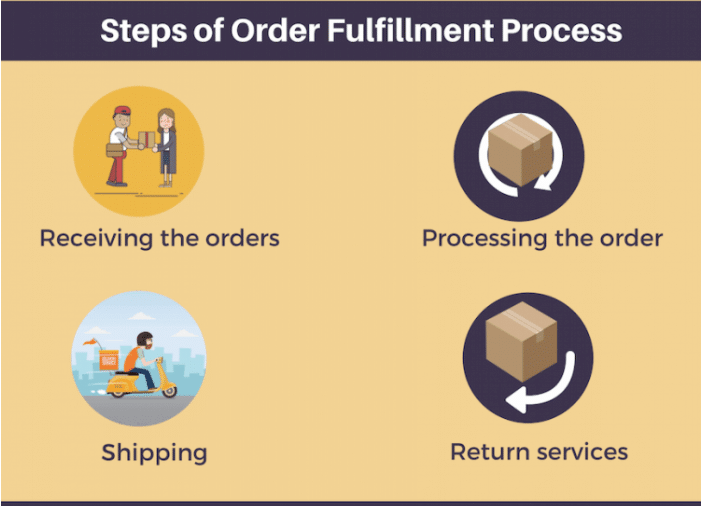
Image by visual.ly
Logistics tend to go awry in the following ways:
The fulfilment expert is away.
- Okay, your expert is off sick, on leave, or otherwise occupied. What do you do now? It’s good practice to maintain distribution as a core competency in your business and train eCommerce teams to understand operations.
Peaks in order volume.
- Prepare for order spikes around the holidays. Take operations up a notch in anticipation of busy periods by scaling the workforce, boosting infrastructure, and ensuring excellent customer care provisions are in place.
Overstretch.
- Brands that choose to manage order fulfilment in-house might get to a point when there’s no longer enough time to spend on growth and customer service. Order fulfilment can fast become all-consuming. Prioritize high-dollar tasks and, when the time comes, consider outsourcing the order fulfilment process.
Insufficient technology.
- To compete with the likes of Amazon, brands and smaller businesses need to mobilize technologies that help to improve turnaround times. ECommerce businesses relying on manual systems will miss out. Automation and data-driven decisions are essential for an effective streamlining of operations.

Photo by CHUTTERSNAP on Unsplash
Ecommerce Fulfillment Services: Pros & Cons
There are pros and cons when it comes to using fulfilment services. ECommerce fulfilment companies have specialist teams and the best eCommerce software to deal with the entire order and delivery process.
Though the cost of outsourcing order fulfilment isn’t right for every business, doing so can be invaluable for those dealing in high order volumes.
Here’s why.
- Order fulfilment services leverage the latest technologies. This helps get your orders processed efficiently and accurately.
- Using an order fulfilment service can help improve branding. Many eCommerce fulfilment providers offer customized packaging options. This is a great way to create a strong brand identity that helps attract and retain customers. This helps expand the reach and keep you memorable.
- Reduced costs all round. Order fulfilment services tend to operate in multiple locations. As such, shipping rates and operating costs can be significantly lower than in-house equivalents.
- More time and space. Outsourcing the fulfilment and shipping process means more time to focus on other important aspects of your business. Elements like marketing and product enhancement. It also helps to free up physical space that could be better utilized for other business operations.
- Some order fulfilment companies even offer designated customer service. Outsourcing customer care can take a great weight off your shoulders, but make sure you choose a reputable service with great customer care reviews.
Partnering with an eCommerce fulfilment service provider can be a great asset. But keep in mind that there are some disadvantages associated with this alternative, too.
- Quality.
Not all fulfilment companies are made equal. Different providers offer different things, and some are hands-down better than others. It would help if you did your research before shaking hands—factor in monthly costs, order volumes, product specialisms, and location. Pick a 3PL provider that integrates easily with your online store.
- Cost.
Order fulfilment services can be costly. For those with large order volumes, the cost can be offset, especially with a bulk, discounted rate. But smaller businesses and startups might want to start by maintaining operations in-house.
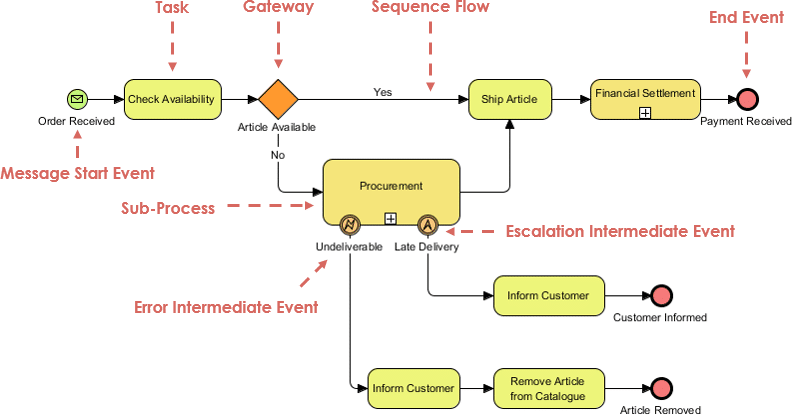
Image by circle visual
It can be difficult for new businesses to estimate their storage requirements and realistic inventory sizes. As such, it’s easy to overspend on a fulfilment service when starting. Common costs include fees for onboarding, storage, packing, kitting, and shipping.
If you think that an eCommerce fulfilment partner could be beneficial for your online brand, that’s great. Do your research. There are lots of services out there, each offering a slightly different experience.
Pick a service that aligns with your brand identity and logistical requirements. To make it easier, we’ve compared the pros and cons of three top eCommerce order fulfilment companies to get you started.
1. ShipBob.
Operating since 2014, ShipBob has been ranked the best fulfilment company overall for its affordable prices, top-rate customer service record, and easy online integrations. This is a great option for Brands looking for a fulfilment service with multiple locations across the US and numerous inventory distribution points.
ShipBob also offers 2-day express shipping, and order tracking, to keep up with the likes of Amazon Prime. Keep in mind that ShipBob doesn’t specialize in B2B or integrate with Amazon products. B2B companies would be better off seeking out specialized B2B eCommerce software solutions.
2. FedEx Fulfillment.
This is a great option for brands that want to ship overseas regularly. FedEx fulfilment will take on regular international shipments and boasts multiple integrations alongside its vast delivery network and longstanding reputation.
FedEx might not be the right choice for brands seeking an all-around customer assistance program, however. Likewise, if your account is likely to fall below FedEx’s minimum, then this is not a good option for you, as you will incur additional costs as a result.

Photo by Liam Kevan on Unsplash
3. Fulfillment.Com.
This is one of the best options out there for international eCommerce companies with high-volume orders. Fulfillment.com uses a cloud-based platform and assigns account managers to each customer.
Same-day order processing is also made possible by the company’s impressive list of fulfilment centres spread across the globe. Unfortunately, customer support is somewhat limited, and the initial deposit fee is not refundable. As such, this is not a great option for startups and early-years businesses.
With the right information at your disposal, you’ll be able to decide whether outsourcing your eCommerce fulfilment is right for you. The most important thing is to choose an operation that meets your needs, from customer service to fulfilment type and integrates with your existing eCommerce platforms.
Third-party logistics can take a great deal of strain out of order fulfilment, but make sure your brand is established enough to deal with this additional expense.
Ecommerce Fulfillment Models
ECommerce fulfilment comes in many different shapes and sizes. Different methods are best suited to different businesses and their fulfilment style. Everything from the products themselves to order volumes and management style will determine which model you choose.
The three principle fulfilment models are delineated as in-house, third-party, and dropshipping. So, let’s explore each one in a bit more detail.
1. In-house.
In-house order fulfilment is otherwise known as self-fulfilment. No surprises here. The in-house model involves completing every step of the fulfilment process internally. In-house operations vary from small-scale operations to investing in a large-scale facility for mass order fulfilment—all without partnering with a third-party logistics provider.
By doing it themselves, eCommerce brands take on everything from securing and licensing warehouse space, to recruitment, investing in equipment, and insurance. This model offers complete control but is incredibly time-consuming.
In-house fulfilment operations can be cost-effective for small businesses. As a business grows more significant infrastructure that integrates communications and multichannel eCommerce software will help keep up with demand.
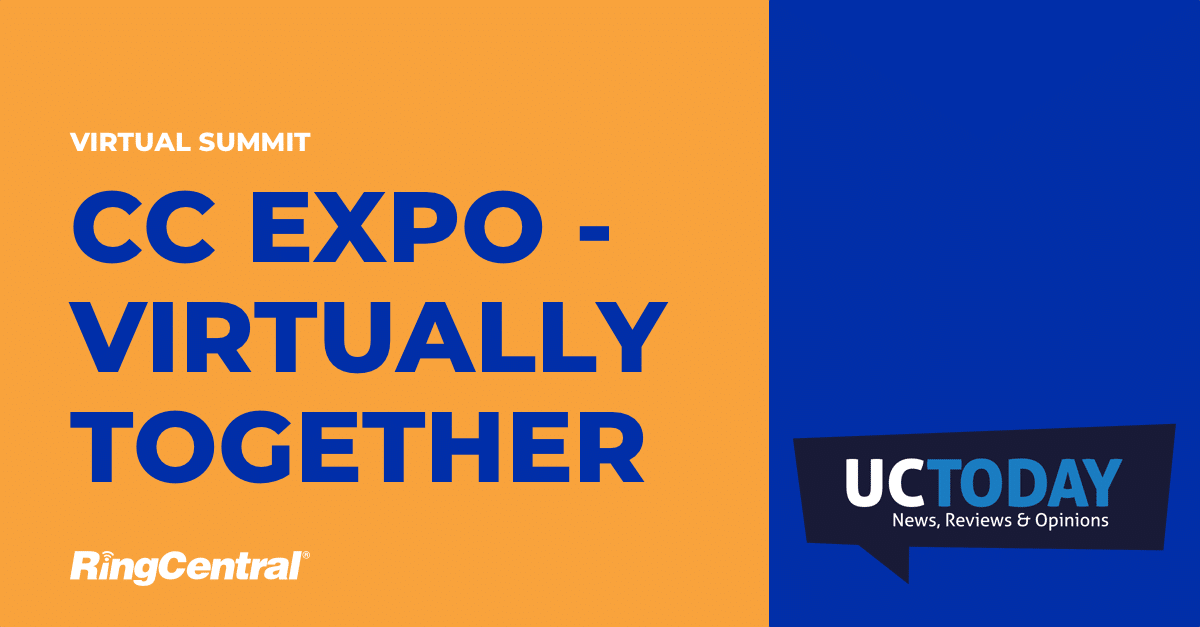
2. Third-party.
Merchants wanting to free up time and/or space tend to opt for third-party fulfilment providers. A 3PL company will manage the fulfilment process in its entirety, from inventories to returns and everything in between.
The opportunity to dispatch from multiple fulfilment centres across different locations is a significant advantage, and using a 3PL provider comes with valuable logistical expertise. Third-party logistics can be cost-effective.
Bulk ordering options keep costs down, and businesses don’t have to worry about hiring their own warehouse space. The main disadvantage is the lack of control, as eCommerce sellers are handing over quality control to a third-party.
3. Dropshipping.
Dropshipping is a delivery fulfilment model that removes the need for inventory management. Under this model, merchants do not hold any products from their online store inventory, on-premises. Nor do they ship orders themselves. Merchants send orders directly to the manufacturer or supplier, who “dropships” the product to the customer.
Dropshipping hands overall shipping responsibility to the manufacturer or supplier. As an easy to start, affordable option that doesn’t incur massive overheads, dropshipping is ideal for testing out new market viability.
Unfortunately, dropshipping leaves little room for customization, quality control, brand marketing, or scalability. As such, it is possibly not the best choice for eCommerce businesses looking to maximize growth and market competitiveness.
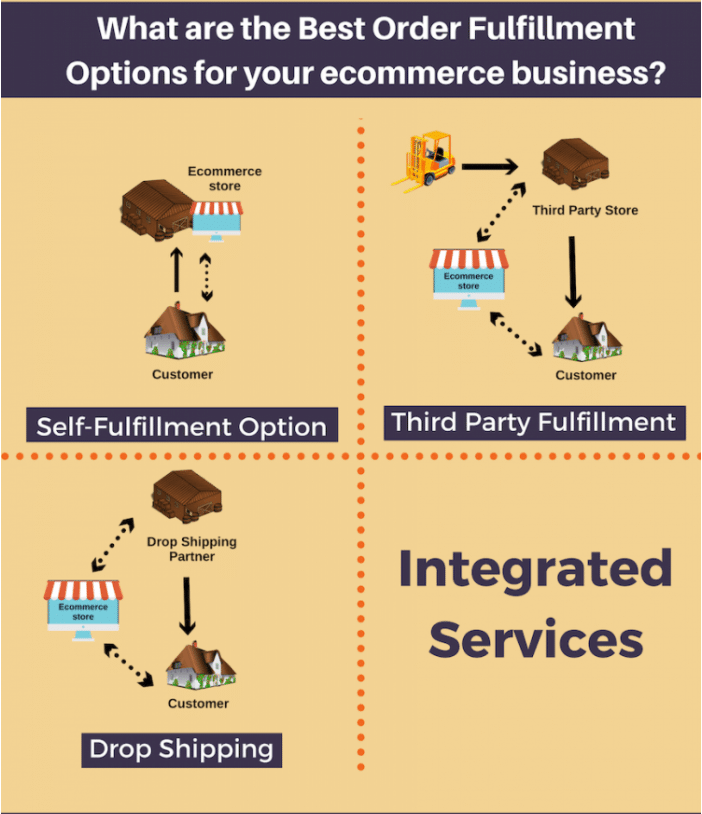
Image by visual.ly
How to Decide on The Right Ecommerce Fulfillment Model For You
These three, very different, eCommerce fulfilment models each have their own unique attraction. In-house operations offer complete, 360-degree control. Third-party services free up time and space, whilst dropshipping reduce costs and hands over shipping responsibilities.
To determine which method is right for your eCommerce company, consider some important questions. Is your business in a position to finance 3PL? If not, are you able to fulfil orders yourself for the foreseeable future? Do you have sufficient space to store your existing inventory? Are your customers satisfied with your shipping options? What are your scaling expectations?
By weighing up these questions, you’ll know what’s right for you at this moment in time. But here’s a summary to help you decide.
|
In-house (small scale operation) |
|
In-house (large-scale operation) |
|
Third-party service |
|
Dropshipping |
Conclusion
Order and delivery fulfilment are essential for any modern eCommerce operation. eCommerce fulfilment involves everything from ensuring delivery options is displayed at checkout, to picking, packing, shipping, and dealing with returns and customer care.
It’s a big operation, but it’s integral to keeping our high-demand, need it now society ticking over smoothly. To compete with the big players in eCommerce, prioritizing your order fulfilment should be the first port-of-call for any business.
Whether you’re a small startup running out of your garage or a large enterprise, fulfilment is central to customer experience. Luckily there are three great fulfilment strategies out there that will get you up and running whatever your particular needs.

Originally published Dec 14, 2020, updated Jan 16, 2023



